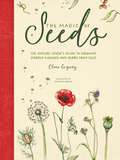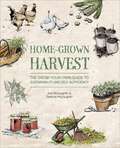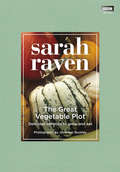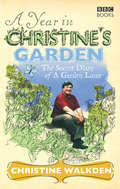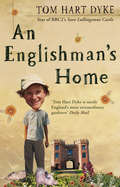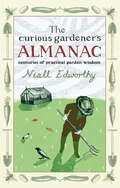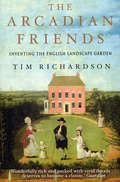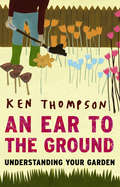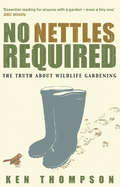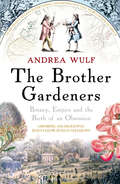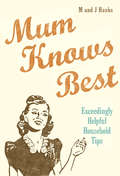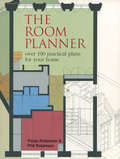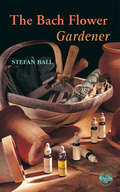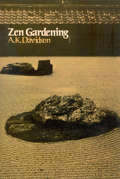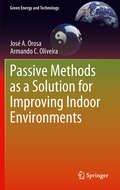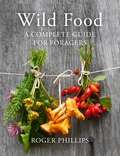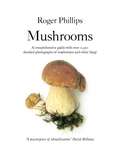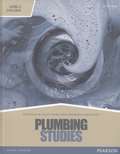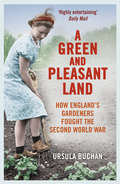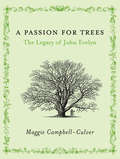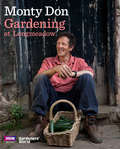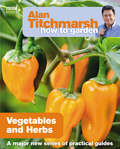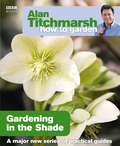- Table View
- List View
The Magic of Seeds: The nature-lover’s guide to growing garden flowers and herbs from seed
by Clare GogertyThe ultimate reference to growing plants from seed. Seeds are magical. Every little one has the potential to become a new plant and give you more seeds - connecting us to the circle of life and nature's endless ability to surprise and delight. The act of planting seeds and watching them grow into seedlings and then on into productive plants is enormously therapeutic. Even when things don't go to plan, the gardener is constantly learning, growing and deepening their connection to nature. It's an incredibly grounding and humbling experience that feeds the soul of the gardener. This beautifully illustrated guide will show readers how and when to harvest the seeds of 100 different garden plants and flowers, with advice on when and how to sow them, and where and when to plant them out. Alongside this hands-on guidance, the reader will be engaged with snippets of folklore and traditions that further enhance their appreciation of nature and help them discover the inherent magic of seeds. Whether the reader is a practising green witch, or simply an amateur gardener with a spiritual affinity with nature, this book will give them everything they need to successfully make a garden from seed and unlock the wonders of nature.
Home-Grown Harvest: The grow-your-own guide to sustainability and self-sufficiency
by Eve McLaughlin Terence McLaughlinGrow your way to happiness with this practical handbook for a more sustainable life. Whether you have a large country garden or a small backyard in the city, this essential guide to the ‘Good Life’ will help you on your journey to becoming more self-sufficient – which is something we all need to be thinking about. Climate change, industrial farming with its reliance on chemicals, rising food prices, fears over food security or just a desire to spend more time outdoors – there are many reasons driving people towards homegrown food and self-sufficiency. Growing your own fruit and vegetables, preserving your produce and generating your own energy are all covered in this thrifty guide by the original ‘Tom and Barbara’, Eve and Terence McLaughlin, who wrote the first edition of this book in 1979. This information-packed book has expert advice on growing, harvesting, storing and preserving your produce. You can brew your own beer and learn how to bottle, cure, smoke and pickle your produce to make it last longer. The book features easy-to-follow instructions for DIY tools and equipment to save money, reduce energy consumption and cut back on waste. Learn how to plan your site, explore the best planting times and methods, discover how to grow a variety of vegetables, fruit and nuts, and how to deal with pests and diseases. As well as growing your own food, the book also covers the basics of keeping livestock – including chickens, ducks, goats and pigs – and how to harness alternative energy sources such as solar and wind power. Putting your own food on the table and playing your part in creating a more sustainable future is hugely rewarding and also has health benefits – the physical exercise of planting and harvesting, the mental wellness that comes with spending time in nature, and the reduction in chemicals in the food you eat – there is so much in this activity that fosters greater wellbeing. Whether you're planning a move to full-blown self-sufficiency or are just curious about what's involved and want to take your first steps to growing your own food, this essential guide has everything you need to know.
The Great Vegetable Plot: Delicious Varieties To Grow And Eat
by Jonathan Buckley Sarah Raven'A vegetable plot is a beautiful thing to make, with the extra bonus of producing the best possible things to eat. If you get it right, the whole place can become your market, your haven and your playground.'So says Sarah Raven in The Great Vegetable Plot, an indispensable practical guide to creating the perfect vegetable garden with the minimum of fuss and effort. By eschewing the timely and unnecessary steps that can frustrate even the most patient gardener, Sarah's principles of speed and simplicity can help you to craft a plot that perfectly suits your needs - and lets you enjoy fresh, home-grown crops all year round.Sarah's straight-forward approach focuses on easy and rewarding vegetables that don't require huge amounts of time or space, meaning you don't need to devout hours to slavishly tending your plot. Beautifully illustrated with over 250 photographs from award-winning photographer Jonathan Buckley, this inspiring guide is ultimately all about pleasure - from the enjoyment you'll get from planting and growing your own produce to the priceless reward of having a wealth of fresh vegetables just outside your door.
A Year in Christine's Garden: The Secret Diary Of A Garden Lover
by Christine WalkdenA Year in Christine's Garden is the utterly down-to-earth account of one woman's passion for plants. Recounting stories from her hectic life in horticulture, Christine Walkden's diary is a heartwarming account of octogenarian neighbours, living with a film crew and helping friends with their gardening needs. Reflecting all the charm of her BBC2 television series, Christine's narrative paints a picture of the day-to-day beauty that surrounds her. She likes being outside, she likes walking her dog Tara, she likes watching the light change and she enjoys those little moments when everything seems right in the world.With irrepressible enthusiasm, she interweaves tips and advice to prove that the best gardens are approachable and achievable. Forget fashion, forget trends - Christine's garden is about no-nonsense planting and growing what you enjoy. As the year progresses, this warm, but frank diary brings to life all the moments of pride, excitement, relaxation and laugh-out-loud fun that make Christine's garden a haven of contentment.
An Englishman's Home: The Adventures Of An Eccentric Gardener
by Tom Hart DykeTom Hart Dyke has a bit of a thing about plants. You might call it an obsession. You might call him certifiable, in fact. But it's a truth universally acknowledged that a single man in possession of a large ramshackle country estate and an obsession with plant collecting could want for only one thing - in Tom's case it's a walled garden containing examples of plants collected from every corner of the globe.Tom's infectious enthusiasm for anything with chlorophyll in it and the hugely ambitious World Garden project he has undertaken at his family home, Lullingstone Castle, in Kent have been documented in a 12-part television series for BBC 2. The first six parts (Save Lullingstone Castle) were shown in spring 2006, and the second six episodes (Return to Lullingstone Castle) in spring 2007 to coincide with hardback publication. Tom's attempts to set up the World Garden aren't exactly straightforward. You might imagine, for example, that the easiest way to start preparing the ground inside the walled Elizabethan garden which he transforms into the main part of the world garden would be to enlist the help of a few people and a lot of hard digging. Well not for Tom, who enlists instead two large pigs, who do indeed do a great job of turning over the earth and fertilising it with great organic manure. But the problem is that they keep escaping into the Hart Dyke family burial plot next door where they start digging up Tom's ancestors...The World Garden is created to bring together a truly amazing collection of plants from every continent and so to show the global origins of the plants we all grow in our gardens. It's already establishing itself as a tourist attraction of some note as well as an educational resource. This is a book for all those who bought Tim Smit's Lost Gardens of Heligan. It's stuffed full of fascinating botanical information as well as the story of Tom's hapless struggle to overcome huge logistical nightmares. It's a riveting, hilarious story of English eccentricity in full bloom.
The Curious Gardener's Almanac: Centuries Of Practical Garden Wisdom
by Niall EdworthyThe Curious Gardener's Almanac contains over 1000 entries of remarkable information about flowers, vegetables, fruits, trees, herbs, insects, birds, water, soil, tools, composts, climate, recipes, gardens and gardeners, myths, superstitions, biodynamics..In short it is a collection as profuse and variegated as gardening itself. Woven into this wealth of knowledge are famous quotations, anecdotes, traditional sayings, lines of verse, and words of rural wisdom. The spirit and focus of the Almanac is British but the wider picture is international as so much of our gardens originated from overseas.Dry or dull information has no place in the almanac and its presentation is as appealing as the content.
The Arcadian Friends
by Tim RichardsonBetween 1715 and 1750, a group of politicans and poets, farmers and businessmen, heiresses and landowners began to experiment with the phenomenon that was to become the English landscape garden. Arguably the greatest British art form ever invented, these gardens were built to charm and delight, to shock and inspire all who visited. That these gardens - including Castle Howard, Stowe, Painshill and Rousham - are still so popular with visitors today is a testament to the innovation and passion of this extraordinary group of eccentrics and visionaries.The Arcadian Friends takes a highly engaging perspective on the politics and culture of England during the Enlightenment. At the same time it will be required reading for the legions of fans of the great gardens of England.Tim Richardson introduces us to a period of poltical and personal intrigue, where fantastic biblical landscapes competed for space with temples to sexual freedom; and where the installation of a water feature was a political act. The Arcadian Friends tells the story of a collection of fascinating characters whose influence changed the landscape of Britain for ever.
An Ear To The Ground: Understanding Your Garden
by Ken ThompsonHow did plants get to be the way they are? Why do they have pretty flowers? How different would things have been if the wrong kind of pollinators had got the upper hand? Why are Latin names so complicated, and why Latin anyway? Why is a weed-free lawn an ecological impossibility?This entertaining book gives the answers to these questions and many more. It shows how a little botanical knowledge can bring not just better results but peace of mind, and that losing sleep over such traditional gardening bogeys as weeds, pests and pruning is not necessarily the best course. In this new edition Ken Thompson grabs the opportunity to explain why any old plant will do for companion planting - but also that it can do as much harm as good - and why planting by the moon is complete and utter nonsense.
No Nettles Required: The Reassuring Truth About Wildlife Gardening
by Ken ThompsonIn 2003 a MORI poll for the Royal Horticultural Society revealed that an extraordinary number of us are interested in attracting wildlife into our gardens. It also indicated, however, that many of us have no idea how to go about it. Information is sparse, and public opinion seems to suggest that gardens that are plentiful in wildlife are unattractive, expensive to upkeep and hard work to maintain. But this couldn't be further from the truth.In this illuminating book, Ken Thompson explains that encouraging wildlife is actually entirely compatible with ordinary gardening, costs next to nothing and is almost completely effortless. Packed with helpful hints and tips, the book shows us how easy it is to fill our gardens with everything from foxes, frogs and mice to butterflies, ladybirds and literally thousands of fascinating creepy-crawlies. Why should we? Because we'll be promoting the biodiversity of the UK, we'll be reconnecting with nature, getting more from our gardens, and we'll be doing our plants a favour.
The Brother Gardeners: Botany, Empire and the Birth of an Obsession
by Andrea WulfOne January morning in 1734, cloth merchant Peter Collinson hurried down to the docks at London's Custom House to collect cargo just arrived from John Bartram in the American colonies. But it was not bales of cotton that awaited him, but plants and seeds...Over the next forty years, Bartram would send hundreds of American species to England, where Collinson was one of a handful of men who would foster a national obsession and change the gardens of Britain forever: Philip Miller, author of the bestselling Gardeners Dictionary; the Swede Carl Linnaeus, whose standardised botanical nomenclature popularised botany; the botanist-adventurer Joseph Banks and his colleague Daniel Solander who both explored the strange flora of Tahiti and Australia on Captain Cook's Endeavour.This is the story of these men - friends, rivals, enemies, united by a passion for plants. Set against the backdrop of the emerging empire and the uncharted world beyond, The Brother Gardeners tells the story how Britain became a nation of gardeners.
Mum Knows Best: Exceedingly Helpful Household Tips
by Jo Hanks Mark HanksHow to you save a curdled custard?How do you keep mice out of the home?How do you stop moths eating your woollens?How do you get chewing gum out of a five-year-old's hair?Or get rid of his veruccas?And cure hiccoughs in a trice?The answers to all these every day dilemmas, and many, many more, are at hand in this nifty little encyclopaedia of essential things every mum needs to know.
The Room Planner: Over 100 practical plans for your home
by Paula Robinson Phil RobinsonMost of us want to improve our homes and to increase their value at the same time, but very few of us have the money to spend on a professional architect. In Room Planner designer Paula Robinson gives you all the ideas and practical information you need to adapt the space in which you live. The book features over 100 clear, colour-coded plans allowing you to pick and choose layouts and designs according to what's appropriate for your home, whether you have a bedsit or a five-bedroom house. To reflect changing lifestyles, the emphasis is very much on versatility and flexibility, with chapters on High-performance space (making maximum use of available space), Valuable space (dividing space to create additional rooms and increase property value), Flexible space (creating moveable partitions) and Individual space (innovative solutions for particular rooms). There's also basic advice and tips, including: Using colour in the home: blue helps to focus the mind and intellect; green has harmonious, soothing effects; yellow stimulates and invigorates; orange stimulates the appetite.Using shapes: the kidney shape brings a softness and flexibility to interiors; circles introduce a sense of freedom and space.Creating atmosphere: an inset fire set higher up in the wall can have a stunning effect; backlit cupboard doors draw the eye; concealed lighting introduces mood and atmosphere while creating a sense of depth; mirroring the wall opposite the entrance door can bring life and character to a property.This is an essential manual not only for homeowners seeking to rethink their living space, but also for those who are building their home from scratch. Paula and Phil's guide will inspire in you the confidence and enthusiasm to maximise the potential of your living space, so that you too can create your dream home.
The Bach Flower Gardener
by Stefan BallPeople all over the world know of the system of 38 flower remedies discovered by Dr.Bach. It is a system so gentle that remedies can be given even to new-born babies with perfect safety. It does not react with other medicines, so that therapists who specialize in other treatments often use it as a complement to their main techniques. Its focus on the emotions makes it a natural partner to the more physically- orientated approaches of most orthodox and non-orthodox medical traditions. And above all it is effective - which is why the use of this system has spread via personal recommendation and word of mouth from one small corner of Oxfordshire to more than 66 countries around the world.It is somewhat less well known that the remedies can be used just as effectively to help plants.Drawing on the experiences of practitioners and correspondents from around the world the author shows just how the remedies can raise the vibrations of plants with the most wonderful results. Readers will come to see the remedies as vital aids to holistic gardening - as essential as any mulch or compost.
Perfect Money Saving (The\perfect Ser.)
by Smita Talati- Do you find you're always strapped for cash at the end of the month?- Are you worried about paying your credit card bills?- Would you like some practical advice on how to make your money go further?Perfect Money Saving is the essential guide for anyone who wants to take control of their finances. Covering everything from home-made presents to cheaper mortgages, it gives step-by-step guidance on how to cut your costs without giving up the things you enjoy. With sections on debt management and your financial portfolio, as well as a month-by-month breakdown showing where and when to grab the best bargains, Perfect Money Saving has all you need to make the most of every penny.The Perfect series is a range of practical guides that give clear and straightforward advice on everything from getting your first job to choosing your baby's name. Written by experienced authors offering tried-and-tested tips, each book contains all you need to get it right first time.
Zen Gardening: Muso Soseki In His Gardens (Michigan Monograph Series In Japanese Studies #56)
by A. K. DavidsonThe Zen gardens of Japan are places in which to meditate. They can be anything from a landscaped garden, complete with waterfalls, to a bed of raked pebbles. This ancient way of gardening goes back to the Zen Buddhist priest-gardeners of the thirteenth century. Based on abstract compositions, relying on simplicity and suggestion, their gardens were designed to liberate the imagination, while providing a starting point in the appreciation of everyday things.Zen Gardening is the first handbook to examine the concepts and techniques that make up this garden art and to apply them to the West. It explains the historical relationship between Zen and the development of gardens, and gives practical suggestions for the creation of a Zen garden at home. The chapters on the garden components and their adaptation for the West, principles of design, and construction work, are illustrated with over 150 line drawings. Step by step they show us how to make the most of corners of large gardens, of plots not large enough for lawns and flower beds, or of awkward passageways, alleys and terraces.The principles of Zen gardening are particularly relevant in our crowded conurbations. Keir Davidson's thoughtful and practical approach enables us to maximize our garden space and to create areas of calm in our own immediate environment. Without precedent in the West, his book will be a source of delight to gardeners of every persuasion.
Passive Methods as a Solution for Improving Indoor Environments (Green Energy and Technology)
by José A. Orosa Armando C. OliveiraThere are many aspects to consider when evaluating or improving an indoor environment; thermal comfort, energy saving, preservation of materials, hygiene and health are all key aspects which can be improved by passive methods of environmental control. Passive Methods as a Solution for Improving Indoor Environments endeavours to fill the lack of analysis in this area by using over ten years of research to illustrate the effects of methods such as thermal inertia and permeable coverings; for example, the use of permeable coverings is a well known passive method, but its effects and ways to improve indoor environments have been rarely analyzed. Passive Methods as a Solution for Improving Indoor Environments includes both software simulations and laboratory and field studies. Through these, the main parameters that characterize the behavior of internal coverings are defined. Furthermore, a new procedure is explained in depth which can be used to identify the real expected effects of permeable coverings such as energy conservation and local thermal comfort as well as their working periods in controlling indoor environments. This theoretical base is built on by considering future research work including patents and construction indications which will improve indoor environmental conditions with evidence from real data. This makes Passive Methods as a Solution for Improving Indoor Environments an ideal resource for specialists and researchers focusing on indoor air quality, thermal comfort, and energy saving or with a general interest in controlling indoor environments with passive methods.
Wild Food: A Complete Guide for Foragers
by Roger Phillips'I can safely say that if I hadn't picked up this book some twenty years ago I wouldn't have eaten as well, or even lived as well, as I have. It inspired me then and it inspires me now' Hugh Fearnley-WhittingstalWild food is all around us, growing in our hedgerows and fields, along river banks and seashores, even on inhospitable moorland. In Roger Phillips and Martyn Rix's Wild Food, hundreds of these plants are clearly identified, with colour photography and a detailed description. This definitive guide also gives us fascinating information on how our ancestors would have used the plant as well as including over 100 more modern recipes for delicious food and drinks. From berries, herbs and mushrooms to wild vegetables, salad leaves, seaweed and even bark, this book will inspire you to start cooking with nature's free bounty.
Mushrooms: A comprehensive guide to mushroom identification (A\pan Original Ser.)
by Roger Phillips'Roger Phillips has written the best mushroom book I know.' Hugh Fearnley-WhittingstallThe culmination of over thirty years' work, Roger Phillips's authoritative and superbly illustrated reference work is packed with the most up-to-date information and original photographs. The essential illustrated mycological encyclopedia, this book is also clear, user friendly and will appeal to a wide range of readers. Unsurpassed in both illustrative and descriptive detail, Mushrooms contains over 1,250 photographs, often showing the specimens in various stages of growth, and includes all the latest botanical and common names as well as current ecological information on endangered species. Having sold more than 750,000 copies in Europe of his previous title on mushrooms, Roger Phillips's Mushrooms once again sets the benchmark. Quite simply, nobody with an interest in the subject can afford to be without this book.
Level 2 Diploma in Plumbing Studies Candidate Handbook (PDF)
by Stephen Blair Phillip Davies Terry Grimwood Andy JeffreyWritten by experienced tutors in line with the level 2 specification to help prepare learners for progression into an Apprenticeship and employment. Professional case studies focus on employability skills and help learners develop the soft skills to aid job hunting and performance in the workplace. The content is logically designed and highly visual which makes plumbing principles easier to digest, understand and remember.
A Little History Of British Gardening
by Jenny UglowDid the Romans have rakes? Did the monks get muddy? Did the potato seem really, really weird when it arrived on our shores?This lively 'potted' history of gardening in Britain takes us on a garden tour from the thorn hedges around prehistoric settlements to the rage for ornamental grasses and 'outdoor rooms' today. It tracks down the ordinary folk who worked the earth - the apprentice boys and weeding women, the florists and nursery gardeners - as well as aristocrats and grand designers and famous plant-hunters. Coloured by Jenny Uglow's own love for plants, and brought to life in the many vivid illustrations, it deals not only with flowery meads, grottoes and vistas, landscapes and ha-has, parks and allotments, but tells you, for example, how the Tudors made their curious knots; how housewives used herbs to stop freckles; how the suburbs dug for victory in World War II.With a brief guide to particular historic or evocative gardens open to the public, this is a book to put in your pocket when planning a summer day out - but also to read in your deckchair with a glass of cold wine, when dead-heading is simply too much.
A Green and Pleasant Land: How England’s Gardeners Fought the Second World War
by Ursula BuchanSHORTLISTED FOR INSPIRATIONAL BOOK OF THE YEAR AT THE 2014 GARDEN MEDIA GUILD AWARDS. The wonderfully evocative story of how Britain’s World War Two gardeners – with great ingenuity, invincible good humour and extraordinary fortitude – dug for victory on home turf.A Green and Pleasant Land tells the intriguing and inspiring story of how Britain's wartime government encouraged and cajoled its citizens to grow their own fruit and vegetables. As the Second World War began in earnest and a whole nation listened to wireless broadcasts, dug holes for Anderson shelters, counted their coupons and made do and mended, so too were they instructed to ‘Dig for Victory’. Ordinary people, as well as gardening experts, rose to the challenge: gardens, scrubland, allotments and even public parks were soon helping to feed a nation deprived of fresh produce. As Ursula Buchan reveals, this practical contribution to the Home Front was tackled with thrifty ingenuity, grumbling humour and extraordinary fortitude. The simple act of turning over soil and tending new plants became important psychologically for a population under constant threat of bombing and even invasion. Gardening reminded people that their country and its more innocent and insular pursuits were worth fighting for. Gardening in wartime Britain was a part of the fight for freedom.
A Passion For Trees: The Legacy Of John Evelyn
by Maggie Campbell-CulverGiven the extent of his influence on 17th-century life, and his lasting impact on the British landscape it is remarkable that no book has been written before about John Evelyn. He was a longstanding friend of Samuel Pepys (who wrote of him, ' A most excellent person he is, and must be allowed a little for conceitedness; but he may well be so, being a man so much above others.'), a founder-member of the Royal Society and a prolific writer and diarist. He was an early advocate of the garden city but his most important work was Sylva: a Discourse of Forest Trees. Sylva was presented to the Royal Society to promote the planting of timber trees 'for the supply of the Navy, the employment and advantage of the poor as well as the ornamenting of the nation.' He was responsible for the first great raft of tree-planting and for a great influx of tree introductions to Britain.Maggie Campbell-Culver's book, like Sylva, has at its core a section detailing the characteristics, history and uses of 33 trees incorporating the advice Evelyn gave and demonstrating its relevance still in the 20th-century. Not only was Evelyn probably the first horticultural writer to show an appreciation of the aesthetic benefits of trees in our landscape, he is shown to be a founder-father of the modern conservation movement.
Gardening at Longmeadow
by Monty DonMonty Don made a triumphant return to our screens as presenter of Gardeners' World. A firm favourite with viewers, Monty's infectious enthusiasm for plants, attention to the finer details of gardening technique and easy charm have seen the ratings soar. Here Monty invites us into the garden at Longmeadow, to show us how he created this beautiful garden, and how we can do the same in our own.Following the cycle of the seasons, Gardening at Longmeadow will introduce readers to the garden from the earliest snowdrops of January through the first splashes of colour in the Spring Garden, the electric summer displays of the Jewel Garden, the autumn harvest in the orchard, and on to a Christmas feast sourced from the vegetable gardens. Describing the magic of each area at different times of the year, Monty will explain the basics of what to do when and how to get the most from each plant. He'll talk through the essential techniques and more complex processes, accompanied by easy-to-follow, step-by-step photography.Longmeadow is a gardeners' garden, but this will be a book for gardening enthusiasts of all skill levels who have been inspired by what they've seen, and who would like to achieve something similar for themselves.
Alan Titchmarsh How to Garden: Vegetables and Herbs (How to Garden #18)
by Alan TitchmarshLearn all the tricks to grow vegetables from seed, maintain mature plants, keep the pests at bay and produce a sustainable crop in your vegetable garden.Includes:* A-Z of vegetables and herbs, how to grow your own and harvest them * advice on feeding, watering and combating pests, weeds and diseases* practical tips on preparing and improving soil* how to manage your plot to ensure year-round produceAlan Titchmarsh imparts a lifetime of expertise in these definitive guides for beginners and experienced gardeners. Step-by-step illustrations and easy-to-follow instructions guide you through the basic skills and on to the advanced gardening techniques, providing everything you need to create and maintain your dream garden.
Alan Titchmarsh How to Garden: Gardening in the Shade (How to Garden #15)
by Alan TitchmarshOvercome the problems every gardener faces with helpful solutions to the problem of shady spots, and handy tips on how to make the most of these notoriously difficult areas.Includes:* creative design ideas for brightening up dark spaces, including north-facing walls* directory of shade-loving plants* care advice for shady lawns and how to deal with moss and algae* ways to achieve year-round colour and interestAlan Titchmarsh imparts a lifetime of expertise in these definitive guides for beginners and experienced gardeners. Step-by-step illustrations and easy-to-follow instructions guide you through the basic gardening skills and on to the advanced techniques, providing everything you need to create and maintain your dream garden.
